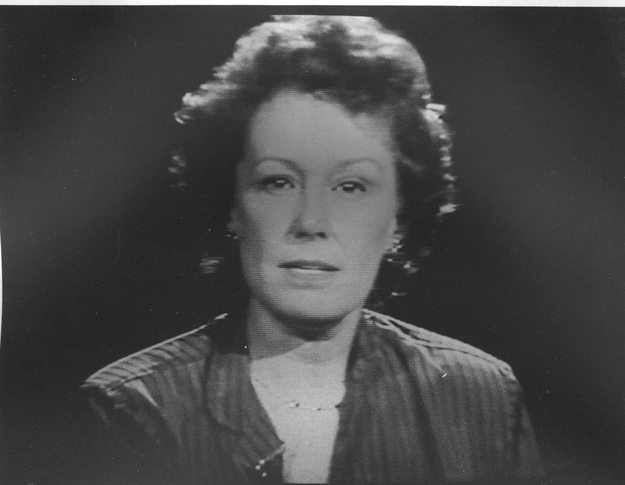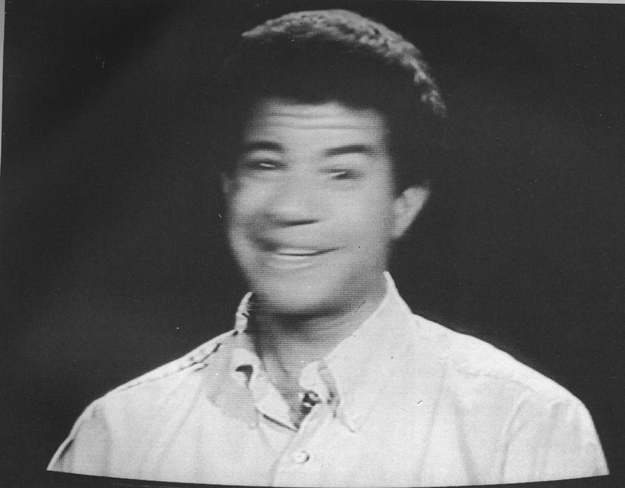Two of these features are the simplicity and clarity with which the work manifests itself to such an extent that an adequate description of it will almost, automatically leeds to needless complication. This brings another feature of Nauman's work to the surface, though in a roundabout way: the discrepancy between language and image.
The work which is probably best designated as a monitor piece, consists of two video tapes, each played on its own monitor. The monitors are placed side by side, sufficiently spaced, and slightly turned inward towards each other, to enable the viewer to look at both screens at the same time. On one monitor a man appears, filling the screen with his head and shoulders. He is looking out of the screen, at the spectator. He starts speaking, saying: I am a good boy, you are a good boy, we are good boys, this is good. At that moment,on the other monitor, a woman appears who starts repeating what the man has just said. She is also facing the spectator. In the meantime the man goes on and repeats the same sequence of sentences, but in which the word good has now been replaced by bad, followed again by both sequences in which boy has given place to girl.
The whole consists of about twenty of these strings, which are repeated continuously. A Walter-and-Connie-like spectacle, exaggerated, and spread over about one quarter of an hour. Each string contains a number of statements that carry a quality notion and that are value determining, such as good, bad, fun, boring, while each string is followed by its counterpart.
The visual image does not change substantially, except the performers facial expression, which is now merry and cheerful, now aggressive, bored or without any marked emotion; either in agreement with what is being said, or quite contrary to the statement that is being made. Intonation also varies continually.
The initial observation, of the woman who is as it were the echo of the man, disappears in the course of time, and both persons seem to have their own text wholly independent from each other. This non-synchronous running of the statements of both persons helps to make the viewer drift into a chaotic situation. A situation in which one is addressed from two sides and in which one gets the feeling of being called upon. The growing intensity of the statements also adds to this feeling. A situation has come about in which one wants to restore order by bringing together, one way or another, the statements of the two persons, through the meaning of those statements. Sometimes one succeeds. For instance when the woman is saying I am alive and the man says at the same time I don 't want to die or This is evil and at the same time This is real good shit. But immediately after that, chaos returns when the various statements cannot be coupled, or cannot be told apart. As mentioned before, the whole lasts about one quarter of an hour. It is however Nauman's intention that the tapes are restarted immediately, so that the whole appears as a continuous process without beginning or end.
Like many of his other works Good boy/bad boy is built upon a complex of contrasts, differentiations and relations. In image: man-woman, light-dark (the woman is white, the man colored), in language: good-bad, eat-drink, love-hate, as well as in the combination of both. The effect is that the content of the statements is either strengthened or deflated. I am a good boy/bad boy, when spoken by the man, has a certain meaning. The same, when spoken by the woman, and as such robbed of direct reference, has become a communication that exists and has meaning in a grammatical sense only. The same effect occurs when This is real boring is being said with a cheerful intonation and a merry face. What remains of the statement is its form, from which, on a different level, a new content arises. What is boredom, love, good or bad, to mention only a few notions.
It appears that the meaning has no single fixed reference, but is dependent on context. The language, spoken or written, which we use every day, proves to be only one of the available means to communicate, to bring about a relationship with reality, to be in the world purposively. Physical behavior, in this case mime and intonation, is just as essential in the transfer of meaning. This tension between language and its meaning is the thread running through this work. This will not be a surprise for anybody who is acquainted at all with Nauman's work. In this respect his neon works are quite clear, especially those that resemble the well-known neon advertisements, the meaning of which varies between extremes by alternate lighting of two letters in the same position. Looking at Good boy/bad boy, one is also reminded of the various spaces where, by means of image or sound, normal observation is distorted, and where the observation is no longer synchronous with what is observed.
In the course of his career Nauman repeatedly made use of video, but he is definitely not to be marked down as a video artist in any strict sense. He uses video as he uses all available materials and media, and from these he chooses what is most appropriate for the realization of his concept at that moment. In this case it was video, rather in the way television is used. He employs the character of the newsreader as we know him, and that of the publicity-doctor, who send their messages into the world in a very penetrating way and who bombard us continually with their truths.
Good boy/bad boy approaches the viewer from two sides. Two persons with opposing statements appeal to the viewer simultaneously, by which the truth nearly automatically comes to lie in between. Two monitors, a man and a woman, with the same text, though slightly different, who contest for the favor of the viewer. This viewer is forced to define his position towards this work in particular, and towards language in general.
It is possible to undergo this work as a parody of certain aspects of television. As a cacophony, on which one frantically tries to impose some direction, and which, as time is getting on, is deteriorating into inarticulate sound of a certain volume. Another possibility is to try, by extreme concentration, to find out what in essence is happening here, and to try to penetrate into the essence of (spoken) language.
Which option you choose, and in whatever way you experience it, both options go together in this work. Ultimately one arrives at the conclusion that this work does not allow a clear and distinct interpretation. It is one as well as the other, and much more.
In this regard one can say about Good boy/bad boy what applies to all the work of Nauman. It is simple and clear, but at the same time enormously complex and elusive.
If you'd like to quote something: Rechman, Lidewijn. "Good Boy/Bad Boy." Mediamatic Magazine vol. 0 # 0 (1985).
Translation: Sjaak Velthoven

